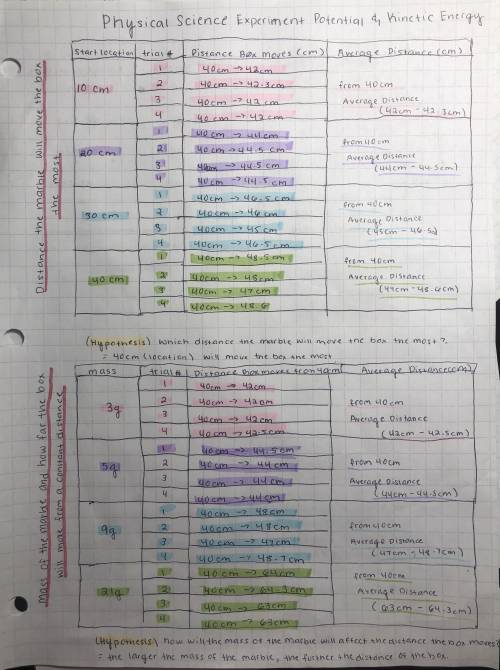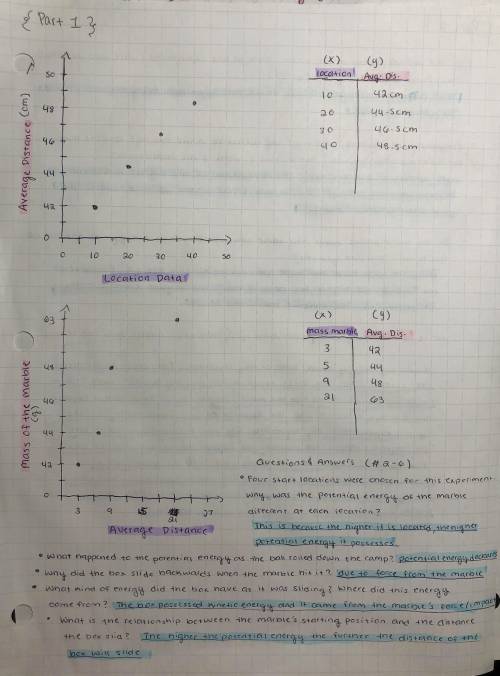
Part 1:
Make a graph of each set of data. For the first set, plot the start location data on the x-axis and the box's average slide distance on the y-axis. For the second set of data, plot the mass of the marble on the x-axis and the average distance the box slides on the y-axis.
Four start locations were chosen for this experiment. Why was the potential energy of the marble different at each location?
What happened to the potential energy as the ball rolled down the ramp?
Why did the box slide backwards when the marble hit it?
What kind of energy did the box have as it was sliding? Where did this energy come from?
What is the relationship between the marble's starting position and the distance the box slid?
Part 2:
All the marbles started at the 40-cm mark in this experiment. Were their potential energies the same? Why or why not?
Comparing the marbles, was there any difference in the average amount that the box slid after catching the marble? What is the relationship?
Do all of the marbles have the same amount of kinetic energy at the end of the ramp? How can you tell?
Write a summary paragraph discussing this experiment and the results. Use the following questions and topics to help guide the content of your paragraph.
According to your data, was your hypothesis for each experiment correct? (Be sure to refer to your data and graphs when answering this question.)
Summarize the conclusions that you can draw from this experiment. Use the questions above to guide your ideas.
Summarize any difficulties or problems you had in performing the experiment that might have affected the results. Describe how you might change the procedure to avoid these problems.
Give at least one more example from real life where the principles demonstrated in this lab are evident.

Answers: 1
Other questions on the subject: Physics

Physics, 21.06.2019 16:10, sruthivada
If two metal balls each have a charge of -10^-6 c and the repulsive force between them is 1 n, how far apart are they? (coulomb's constant is k = 9.0x 10^9 n-m^2/c^2? 9.5 m 9.0 mm 9.5 cm 0.9 m .
Answers: 3

Physics, 22.06.2019 02:20, shadoris26
According to newton’s first law of motion, which force is expected to cause a body to accelerate?
Answers: 1

Physics, 22.06.2019 02:30, JanaMiqdad1003
Agas initially at p1 = 1 bar and occupying a volume of 0.5 liter is compressed within a piston–cylinder assembly to a final pressure p2 = 4 bar. (a) if the relationship between pressure and volume during the compression is pv = constant, determine the volume, in liters, at a pressure of 3 bar. (b) repeat for a linear pressure–volume relationship between the same end states. reference
Answers: 1

Physics, 22.06.2019 14:30, mangowammy
What conclusion can be made based on the temperature of soil when the light hits the soil at 0°, 45°, and 90° angles in section 2 of the experiment? did your results support your hypothesis? why or why not?
Answers: 1
Do you know the correct answer?
Part 1:
Make a graph of each set of data. For the first set, plot the start location data on the x-...
Questions in other subjects:







Biology, 14.07.2019 00:40

Mathematics, 14.07.2019 00:40

History, 14.07.2019 00:40

History, 14.07.2019 00:40









